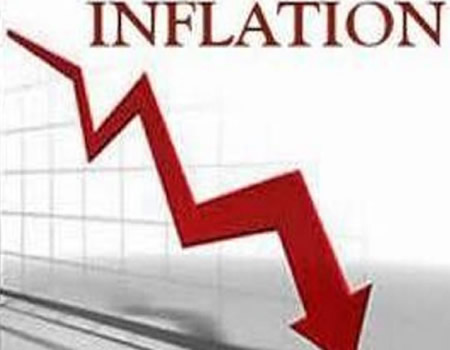The National Bureau of Statistics (NBS) has announced that Nigeria’s inflation rate dropped to 11.08 per cent in July from 11.22 per cent in June, for the second consecutive month, the lowest since February 2016.
This was contained in the NBS Consumer Price Index report, released recently in Abuja .

The index measures inflation in the country. According to the report, Nigeria had also recorded a drop in inflation in June as the rate dropped from 11.40 per cent in May to close at 11.22 per cent.
However, in its latest report on inflation, the NBS, stated that the Consumer Price Index (CPI) recorded a year-on-year increase, adding that the difference in month-on-month decline between June and July 2019 was 0.14 per cent.
It said, “The consumer price index increased to 11.08 per cent (year-on-year) in July 2019. This is represents 0.14 per cent points lower than the rate recorded in June 2019 (11.22 per cent).
“On month-on-month basis, the headline inflation index increased by 1.01 per cent in July 2019. This shows 0.06 per cent rate lower than the rate recorded in June 2019 (1.07) per cent. The percentage change in the average composite CPI for the twelve months period ending July 2019 over the average of the CPI for the previous twelve months period was 11.29 per cent, compared to 11.29 per cent recorded in June 2019.”
The bureau stated that the urban inflation rate increased by 11.43 per cent (year-on-year) in July from 11.61 per cent recorded in June, while the rural inflation rate increased by 10.64 per cent in July from 10.87 per cent in June.

On a month-on-month basis, it said the urban index rose by 1.07 per cent in July, down by 0.03 from 1.10 per cent recorded in June, while the rural index also rose by 0.96 per cent in July, down by 0.09 from the rate recorded in June, which was 1.05 per cent.
The bureau said, “The corresponding 12-month year-on-year average percentage change for the urban index is 11.64 per cent in July.
“This is less than 11.65 per cent reported in June, while the corresponding rural inflation rate in July is 10.97 per cent compared to 10.99 per cent recorded in June.”
The NBS report stated that the composite food index rose by 13.39 per cent in July compared to 13.56 per cent in June. “This rise in the food index was caused by increases in prices of oils and fats, meat, bread and cereals, potatoes, yam and other tubers, and fish,” it stated.
It added, “On month-on-month basis, the food sub-index increased by 1.26 per cent in July, down by 0.10 per cent points from 1.36 per cent recorded in June.”
It further stated that the ‘all items less farm produce’ or core inflation, which excludes the prices of volatile agricultural produce stood at 8.80 per cent in July, down by 0.04 per cent when compared with 8.84 per cent recorded in June.
The composite food index rose by 13.39 percent in July 2019 compared to 13.56 percent in June 2019. This rise in the food index was caused by increases in prices of Oils and fats, Meat, Bread and cereals, Potatoes, yam and other tubers, and Fish.
On month-on-month basis, the food sub-index increased by 1.26 percent in July 2019, down by 0.10 percent points from 1.36 percent recorded in June 2019.
The average annual rate of change of the Food sub-index for the twelve-month period ending July 2019 over the previous twelve-month average was 13.46 13.42 percent, 0.04 percent points from the average annual rate of change recorded in June 2019 (13.42) percent.
The ‘’All items less farm produce’’ or Core inflation, which excludes the prices of volatile agricultural produce stood at 8.80 percent in July 2019, down by 0.04 percent when compared with 8.84 percent recorded in June 2019.
On month-on-month basis, the core sub-index increased by 0.77 percent in July 2019. This was down by 0.08 percent when compared with 0.85 percent recorded in June 2019.
The highest increases were recorded in prices of Medical and Hospital services, Cleaning, Repair and hire of clothing, Repair of household appliances, Major household appliances, Domestic and household services.
The average 12-month annual rate of change of the index was 9.52 percent for the twelve-month period ending July 2019; this is 0.12 percent points lower than 9.64 percent recorded in June 2019.
According to Investopedia, deflation, or negative inflation, happens when prices fall because the supply of goods is higher than the demand for those goods. This is usually because of a reduction in money, credit or consumer spending.
This can be caused by a combination of different factors, including having a shortage of money in circulation, which increases the value of that money and, in turn, reduces prices; having more goods produced than there is demand for, which means businesses must decrease their prices to get people to buy those goods; not having enough money in circulation, which causes those with money to hold on to it instead of spending it; and having a decreased demand for goods overall, therefore decreasing spending.
While it may seem like lower prices are good, deflation can ripple through the economy, such as when it causes high unemployment, and can turn a bad situation, such as a recession, into a worse situation, such as a depression.
Deflation can also lead to unemployment because when companies make less money, they react by cutting costs in order to survive. This includes closing stores, plants, and warehouses and laying off workers.
These workers then have to decrease their own spending, which leads to even less demand and more deflation and causes a deflationary spiral that is hard to break. The only time deflation can work without hurting the rest of the economy is when businesses are able to cut the costs of production in order to lower prices, such as with technology.
The cost of technology products has decreased over the years, but it is because the cost of producing that technology has decreased, not because of decreased demand.
On the other hand, one might think that a general decrease in prices is a good thing because it gives consumers greater purchasing power. To some degree, moderate drops in certain products, such as food or energy, do have some positive effect on consumer spending. A general, persistent fall in prices, however, can have severe negative effects on growth and economic stability.
The summary is that a little bit of inflation is good for economic growth – around 2% to 3% a year. But, when prices begin to fall after an economic downturn, deflation may set in causing an even deeper and more severe crisis.
As prices fall, production slows and inventories are liquidated. Demand drops and unemployment increases. People choose to hoard money rather than spend because they expect prices to drop even more in the future.
Defaults on debt increase and depositors withdraw cash en masse, causing a financial meltdown defined by a lack of liquidity and credit. Central banks and governments react to stabilize the economy and incentivize demand through expansionary fiscal and monetary policy, including unconventional methods such as quantitative easing. All in all, a deflationary period is dangerous for a country’s economy.















